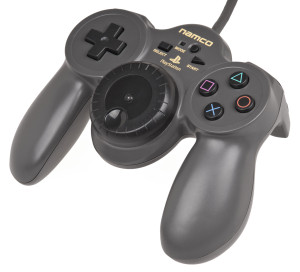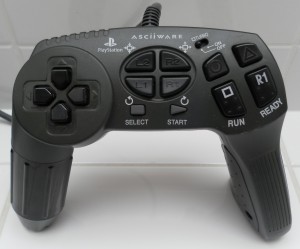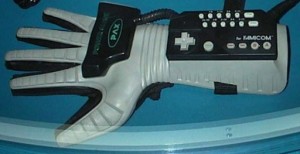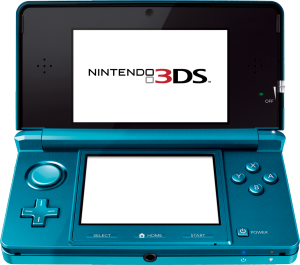Some Of Gamings (Almost) Useless Peripherals
Nintendo really hit the nail on the proverbial with the D-Pad; not since the first transplanted Englishman looked around at the kangaroos and sand and enquired how to get back home to good ole Blighty (once their prison sentence was served) has a question been so important to the world than the one asked by a clever bod in Nintendo-Towers. How best to wrest control and get the tiny figure on screen moving?
Since then they have branched out to include analogue manipulation within the gaming world for optimum control, with all and sundry offering their own interpretation of the tech with various add-ons and after market cash-ins geared towards offering the discerning gamer-cum-consumer near enough the exact same thing delivered in a different plastic moulding for no real benefit other than owning another dust gathering shelf-filler in your game-room and relieving them of some weight in their wallet.
Sometimes, however, they go that one step further in providing us with an uncomfortably pricey and sometimes unique-to-one-game way of both interacting with and thoroughly ruining our favoured pastime hobby.
Such as…
Jogcon
 With a name derived from the ‘jogging’ of a dial and bearing the Namco logo on its front, the Jogcon was the first truly force-feedback enabled controller released for the PSX.
With a name derived from the ‘jogging’ of a dial and bearing the Namco logo on its front, the Jogcon was the first truly force-feedback enabled controller released for the PSX.
Sporting a disc some 3 inches in diameter at its centre and standard PS1 buttons mapping everywhere else, the Jogcon was primarily bundled with Ridge Racer 4(R4) before finding a stand alone release on gaming store shelves – in both senses of the word, as it turned out the demand for an overly priced and apparently single-game-use device bundled without said game proved to be somewhat lacking to say the least.
PlayStation owners already had the perfect device with which to manipulate both digital and analogue-style worlds of digital dreams by the time Jogcon came out. The effort in trying to turn the tiny disc with just the edges of the thumbs to mimic a real-world driving thrill seemed too much for those replete with some Sony twin stick shenanigans.
Instead of an almost therapeutic vibrating of the wrist bones to accompany a Paginni pile up, users of the Jogcon experienced a fight to retain both thumbs upon the disc as the brutality of feedback wrenched the centre circle beneath chaffing piggies. The struggle was like one attempting to escape the machinations of some erstwhile kidnapper.
Time invested and thumb muscles built would open up a new world of control to those dedicated to drive; the level of control and immersion within the world of racing afforded by the Jogcon was on another level when compared to the standard Sony ‘Sticks.
It looks like a pair of plastic legs deliberately exposing their ginormous plastic scrotum in what feels like the same level of pride a child shows off how pretty its bowel movement looks when smeared up the bedroom wall. It feels cheaper than a set of action eight figures from a £-store at the rough end of town, and is close to the very definition of ‘strictly limited’ as you can get when discussing compatibility with other genres or even other racing games.
And even though its true accelerating and braking are once again back in the non-progressive ‘Go’ and ‘Stop’ of digital shoulder button bashing, there is something to be said for truly experiencing the pull of the road or loosing of grip as the disc fights you around the many corners of the track. Feeling a slide before it has begun and correcting it in time to power-slide your way across the finish line and into the world of top-scoring gamers called either ‘ASS’ or ‘A$$’. It is manna to the inner motor-head, puts lead in your petrol, and looks classy as all hell on the replays.
Resident Evil 2 Gun Controller
 With a twisty-turny ‘realistic’ right grip to mimic the twisty turny action of a real-world gun and a left grip designed to be similar to that on the handle of a combat knife, and a completely different button mapping to every other controller released on the system to ensure even those who were prepared to look past all that would still be punished for their purchasing every time they hit what they forgot was no longer the button for their inventory; the Resident Evil 2 Gun Controller was an award winning disaster.
With a twisty-turny ‘realistic’ right grip to mimic the twisty turny action of a real-world gun and a left grip designed to be similar to that on the handle of a combat knife, and a completely different button mapping to every other controller released on the system to ensure even those who were prepared to look past all that would still be punished for their purchasing every time they hit what they forgot was no longer the button for their inventory; the Resident Evil 2 Gun Controller was an award winning disaster.
Released by Ascii Entertainment and featuring the aforementioned button configuration that saw shoulder buttons reduced to one trigger like confection and the button to run positioned front and almost centre and labelled ‘RUN’ in stark white lettering against the controllers deep black plastic self. This wasn’t just a pad you’d have difficulty playing any other game with; this was a pad you could barely play its game with.
Camera angles that deliberately mis-footed the player and enemies that used such things to their advantage by hiding on the edges of the screen and rubbing their tummies in hungry anticipation compounded the clunky feel of the pad in the hand; the shooting of enemies by way of the ‘trigger’ on the right stick (‘Like a real gun, see?’) and the unspoken assurance on the makers part that you would be needing to find that RUN button with as little fuss or faff as possible by slamming it right up there under your nose, and you have the ‘Fat-Pad-Friend’ in your collection; fun to get together with and have a mess about on from time to time, but no amount of dedicated trigger action or full frontal font is worth writing home about.
The PlayStation Glove
 Forget the Nintendo Power Glove; this is the PlayStation Video Game Control Glove, a completely different and totally unique idea of gaming control and power and plastic and…glove…um…yeah…
Forget the Nintendo Power Glove; this is the PlayStation Video Game Control Glove, a completely different and totally unique idea of gaming control and power and plastic and…glove…um…yeah…
Having learned how to make world class all conquering consoles after Nintendo gave them the crib notes. Sony dipped further into the big N’s pot of gaming gumbo with this wonderfully inept piece of plasticy inputting rubbish.
Featuring an immobile set of ‘fingers’ resplendent with difficult to press symbol buttons, a twisting wrist-piece that has delusions of replacement, Jedi arm parts that promise a new level of interaction and immersion to move you through dimensions as well as levels, oh and about the same amount of ‘cost-of-controller + effort-involved – games-that-are playable/will-work = fun attained’ as the original NES nonsense of yore.
Other than slurs inferred by the ‘one handed action’ of such a control, there’s a lot to dislike about the ‘Glove. The bare-bones appearance of the ‘Glove – replete in a Spinal Tap none-more-black confection, of course -isn’t helped by the swathe of Velc- self-affixing material stitched thick to maintain attachment to the owner’s/wearer’s arm. Needing someone to help strap you into the thing could have been a clever way of integrating other family members and non-gaming other-halves into the world of games by way of requiring their presence nearby whenever the call of Crash was being heard, and it feels more like they’re silently acknowledging anyone giving serious consideration to this device may be the same sort of gamer whose fridge is within reaching distance of the chair, and may be in need of something that allows a little room-to-grow.
Once ensconced and wired-up the pad reveals its trump card of control; by careful movements of the wrist one can manipulate the avatar or car on screen in any desired direction, replacing the depressing of a digital d-pad.
With actions undertaken by the subtle digit depressing of fingertip onto a layout spread across the ‘Gloves own, it’s as if you are in control of the hand of Merlin himself, your actions mysterious, but the results spectacular.
As you can imagine, the actual application of gaming falls somewhat short when the ‘Glove gets its chance to shine; despite three analogue settings to allow any game – whether analogue or not – to be given a ‘new lease of life’ when played with the device, the reality of using anything other than an actual tactile lump sucks the fat right out the dead otters maw. Ridge Racer becomes an experience of driving every straight bit sideways and every corner backwards, and you may as well forget about Tekken if you ever wish to know the pleasure of self-fulfillment again. Trying to press the right button means remembering which ‘finger’ it’s on and with the just-off placing of each there’s no end to the constant shifting and re-affixing of the ‘Glove in an attempt to make them just a bit more workable.
3D
Okay, so not strictly speaking a gaming peripheral per se, but shut up.
 3D gaming has been the long held dream of developers for all of about five minutes, and since Cameron made a film about cats and blue and whatever that advert disguised as a film was supposed to be about, the reality of having Mario constantly thrust out onto their platforms and into our faces has seen Nintendo become holders of the 3D game reins.
3D gaming has been the long held dream of developers for all of about five minutes, and since Cameron made a film about cats and blue and whatever that advert disguised as a film was supposed to be about, the reality of having Mario constantly thrust out onto their platforms and into our faces has seen Nintendo become holders of the 3D game reins.
Not content with almost destroying the idea of marrying the third dimension with gaming forever through the migraine inducing Virtual Boy, Nintendo took another shot at the realm of the almost-there with their far-more portable and less blood-vessel bursting handheld console, the Nintendo 3DS.
Launching it as not just the natural successor to the DS but to the world of gaming and how we game at a fundamental and life-changing level proved the big N still had big enough mouths to amply fit their Mario branded sneaker shod feet into.
A screen that displays an image of three dimensions by basically forcing your eyes out of focus negated the need for facial furniture for the effect to become apparent. A slider bar to find the sweet spot of trading the feeling of slightly sore eyes for almost depth-induced gaming, a rigid seated position to maintain optimum distance between gamer and device, and a tilt function that throws the first two ideals straight into the shitter by forcing you to pull the ‘dog looking puzzled’ head tilt as you move and turn the console about, and the number of games now visibly lauding their 3D elements within the game has dropped off significantly.
Early releases implemented an isometric, over-the-shoulder-almost-but-the-screens-too-small-to- make-it-work-properly or backgrounds that simply scrolled along at a slightly different speed to the fore- hardly showed an industry fully capable of capitalizing on this ground breaking tech. Nintendo has pushed ahead and continued to put the extra dimension into their canon and self published releases, but in a way that feels embarrassed and that if they didn’t’t it could be perceived as them admitting nobody has the first clue what to do with it now they’ve wasted all that money on the research.
And without the 3D element all that’s left is a slightly more expensive DS that is easier to get online and has a slightly better looking screen but still leaves anyone using the Mii-verse feeling like a creepy predator whenever they go online to see if anyone has any ‘berries’ to ‘trade’.


